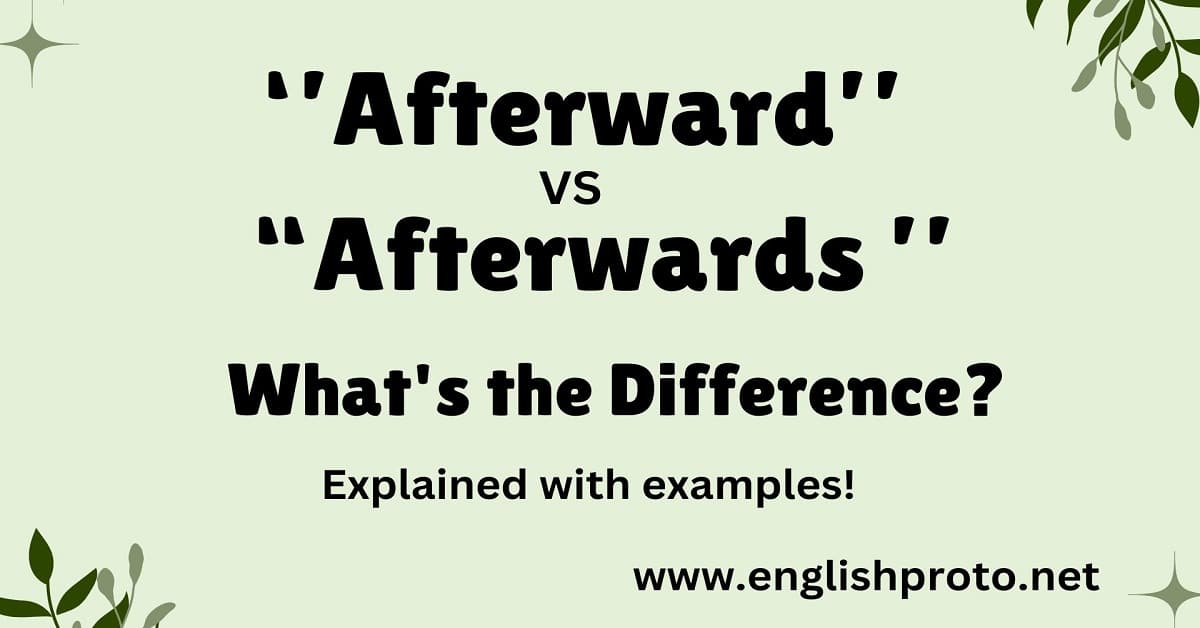Afterward vs Afterwards: What’s the Difference? Have you ever wondered about the difference between Afterward and Afterwards? These two seemingly similar words can often cause confusion in both writing and everyday conversation.
While they share a common meaning, something that happens at a later time, they are used differently depending on the context and region. Whether you’re drafting an email, writing a report, or simply trying to understand proper grammar, it’s essential to know when to use Afterward vs. Afterwards.
In this article, we’ll break down the key distinctions between these terms and provide practical examples to help you master their usage. By the end, you’ll have a clear understanding of how to use them confidently in your writing!
⚡ Quick Summary
- Afterward is the American English spelling of the term.
- Afterwards is the British English form of the same word.
- Both refer to something that happens at a later time but differ in usage based on geographic regions.
- Understanding these differences improves writing clarity and ensures effective communication.
Reasons for Confusion
The confusion between afterward and afterwards often stems from their phonetic similarity and the fact that both can describe a similar concept, something occurring after an event. However, regional variations and differences in pronunciation further contribute to this confusion.
Pronunciation:
- Afterward is consistently pronounced as “after-ward” in American English.
- Afterwards is pronounced as “after-wards” in British English, with a slight variation in how the final syllable sounds.
Regional Influences:
- In American English, afterward is the standard form, and is more commonly used in everyday and professional contexts.
- In British English, afterwards is the preferred form, used in academic, literary, and journalistic writing.
Understanding this distinction is important, especially for international communication and for writers who work across different English dialects.
Detailed Explanation
Meaning and Usage
The term afterward can be broken down into its two components: after, meaning “later in time,” and ward, which often implies direction or relation to something.
When combined, afterward simply denotes something that occurs following a specific event or situation. Similarly, afterwards holds the same meaning but with a slightly different spelling, reflective of British English standards.
- Afterward: Used primarily in American English, this form is straightforward and often used in everyday speech and writing.
- Afterwards: Commonly used in British English, this form carries the same meaning but is preferred in British writing contexts.
Contextual Use
In American English:
- “We had a discussion, and afterward we went for coffee.”
In British English:
- “We had a discussion, and afterwards we went for coffee.”
Here, both examples illustrate how the context dictates which form is used based on regional preferences.
Common Errors
One of the most common mistakes writers make is using the incorrect form in the wrong context, often due to confusion with similar-sounding words or their placement within sentences. Here are a few incorrect variations and why they should be avoided:
Incorrect Variations and Why They Should Be Avoided
- After words: This is incorrect as it combines “after” with “words,” which is not a valid usage.
- Correct Usage: Use afterward or afterwards instead.
- After word: Similarly, using “word” singularly following “after” doesn’t make sense in this context.
- Correct Usage: Stick to afterward or afterwards for proper meaning.
Both of these variations fail to accurately convey a temporal relationship, which is the main purpose of using afterward or afterwards.
Synonyms and Alternatives
When it’s necessary to avoid afterward or afterwards, other synonyms and alternatives can be used, depending on the context:
- Subsequent: Often used to describe events or actions that follow another event.
- Example: “The meeting was postponed, and a subsequent session was scheduled.”
- Following: Used to indicate events that come next in a sequence.
- Example: “We discussed the agenda, following which we broke into groups.”
These alternatives may work well in various contexts, but they may not carry the exact nuance that afterward and afterwards do, which specifically focus on the passage of time.
Examples in Sentences
Incorporating practical examples helps to distinguish the use of afterward vs. afterwards:
Examples in American English:
| Sentence | Correct Usage |
|---|---|
| The event concluded, and we left afterward. | Correct for American English. |
| She visited the library, and afterward went for a walk. | Correct for American English. |
Examples in British English:
| Sentence | Correct Usage |
|---|---|
| The event concluded, and we left afterwards. | Correct for British English. |
| She visited the library, and afterwards went for a walk. | Correct for British English. |
These sentences reinforce how the regional distinctions between afterward and afterwards influence word choice.
Origins and History
Afterward and afterwards have roots in Old English, where similar terms existed to describe events occurring at a later time. Over the centuries, these forms have diverged, with afterward being the American variant and afterwards the British. This divergence showcases how languages evolve and adapt based on geographic and cultural influences.
Conclusion: Afterward vs Afterwards
Mastering the correct use of afterward and afterwards is essential for writers, educators, and professionals aiming to communicate clearly and effectively. Despite their shared meaning, these terms differ primarily through regional usage, pronunciation, and subtle spelling variations.
By understanding when and how to use afterward vs. afterwards, writers can ensure their work resonates across diverse audiences and maintains a polished, professional tone.
Whether you’re composing an academic paper, a professional email, or a creative piece, applying the correct form based on your intended audience enhances the quality and clarity of your writing.



